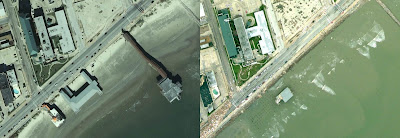The aftermath of Hurricane Ike
September 15th, 2008 | Published in Google Earth
Three days after Hurricane Ike slammed into Galveston, Texas as a Category 2 hurricane, severe flooding has challenged Gulf Coast residents from Texas to Louisiana. A team at Google has been gathering information we hope will be useful to residents of the affected regions and the relief agencies working to help them.
Imagery from NOAA
After Hurricane Ike came ashore in the wee hours Saturday morning and as the weather cleared, NOAA's Remote Sensing Division began flying rapid response aerial reconnaissance missions of the Texas and Louisiana Gulf region. This aerial imagery is intended to provide emergency managers with a broad view of damage and residual flooding, so that they can prioritize and direct response to aid those in greatest need in the affected regions. It is also of potential use to those who have been evacuated from these regions or may have loved ones impacted by the storms. The NOAA team has published the data they have collected so far on their official Hurricane Ike response page, and members of the Google Earth team have processed it into a KML image overlay for easy access by anyone. To view the imagery in Google Earth, click here to download the KML file, which also contains images of flooding in Louisiana.
Here's a sample of before & after imagery of battered islands and structures on the Texas coast:
House & road damage near Gilchrist, Texas
 Image courtesy Houston-Galveston Area Council (L) / Image Courtesy NOAA (R)
Image courtesy Houston-Galveston Area Council (L) / Image Courtesy NOAA (R)
Oil spill near Crystal Beach, Texas
 Image courtesy Houston-Galveston Area Council (L) / Image Courtesy NOAA (R)
Image courtesy Houston-Galveston Area Council (L) / Image Courtesy NOAA (R)
Destroyed docks in Galveston, Texas
 Image Courtesy NOAA (R)
Image Courtesy NOAA (R)Hurricane Ike, post-storm imagery and photos: View in Google Earth
Hurricane Gustav, post-storm imagery: View in Google Earth (more imagery has been added since the previous blog post).
UPDATE (9/19): We've added a significant amount of new imagery to the Hurricane Ike KML, including imagery through Sept. 17.